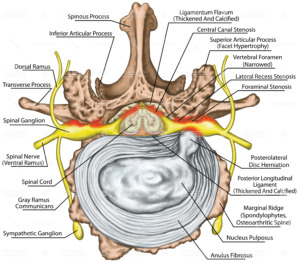Your spine is made of a series bones called vertebrae stacked on top of each other with a rubbery disc in between. The disc is like a shock absorber. The spine has a canal in the back where the spinal cord runs and the nerves come out either side. The nerves and spinal cord are like the wires of the internet or phone system. The discs are made of two components: a soft jelly like center (called nucleus pulposus) surrounded by an elastic ring of cartilage (called annulus fibrosus). There are many layers of rings in the annulus fibrosus organized in a criss cross fashion.

A disc protusion occurs, when the several layers of rings in the cartilage breakdown or tear and the soft jelly like center bulges out beyond the edge. But it doesn’t break all the way through. An extrusion is when the soft jelly like center or annulus pulposus breaks through all the rings of cartilage and protrudes out into the area where the nerves and spinal cord are located. Then you have a sequestration. This is where the disc material breaks free and floats the nerve roots and spinal cord. The pain occurs, when the disc presses on a nerve or the spinal cord. The disc itself isn’t the main source of pain.
down of the rings of fibers in the disc. Then there is “the straw that breaks the camel’s back”. This usually is some kind of movement like bending over and twisting at the same time. Car accidents and traumas are another big cause. As time goes on the disc fibers breakdown more and more and the disc loses height. This is why younger people will tend to have real disc extrusions more often than older people, because the disc hasn’t lost as much height. Older people suffer from spinal disc degeneration.

Chiropractic care helps maintain disc health.
One of the main causes of disc problems is vertebral misalignment and loss of movement in the spinal joints. Chiropractic care helps with both scenarios. Adjustment work to restore the alignment and restore the movement in the vertebrae of the spinal column. In my office I also use a type of spinal decompression called Cox technique or Flexion Distraction to open the disc spaces. This is a hands-on technique, where I use my hands and moving table to stretch and open up the disc spaces. I can target individual discs and vertebrae, whereas other spinal decompression techniques just stretch the whole lumbar spine. I also use ultrasound, laser, microcurrent and interferential electrical stimulation and soft tissue techniques. Exercise is always essential. I have saved may people from surgery.
